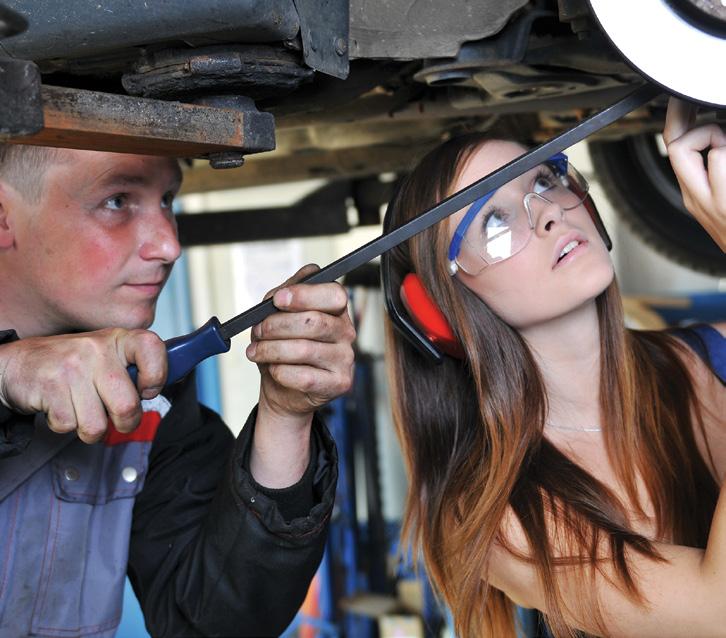
9 minute read
In the workshop - Reaching out to the next generation
REACHING OUT TO THE NEXT GENERATION
As we continue to deal with our industry’s ongoing skills shortage, attracting the next generation to automotive is a hot topic
The way to solve a skills shortage might seem easy on the face of it – simply get more people into the industry! The actual matter of growing industry participation is a complex one however, in what is an increasingly cluttered and competitive careers market. While attracting mature-aged workers to the industry is an integral part of this puzzle, in this article I want to focus on ‘the next generation’ – that is, school leavers. While less young people may be growing up helping their parents fix the family car in the driveway and fewer secondary schools have a dedicated ‘trade’ component within their facilities compared to decades past, it is heartening to see many secondary schools encouraging students to consider the trades, including automotive, as a viable career option. “There are a number of our public schools that have specialist automotive trade training centres. Students attending these schools have access to current industry trainers, industry standard facilities and nationally recognised automotive training at school. Some schools also offer automotive vocational preparation training on school site by qualified trainers,” Executive Director Statewide Services for the WA Department of Education, Martin Clery, said. “Automotive industry-based training is also delivered by TAFE Colleges and private providers. Students typically attend these training facilities or engage in employment-based training with an employer one to two days per week during Years 11 and 12. Some students are successful in securing an apprenticeship and leave education to access these opportunities full time.” “Schools value automotive training as a strong and viable pathway for students that can lead straight into meaningful work,” said Jodie Fitzsimmons, VET Coordinator for the North Metropolitan Education Regional Office of the WA Department of Education. “The number of schools that support students to complete automotive training – both in school through registered training organisations, and by facilitating access to external training – clearly indicates that schools value highly the pathways provided by this industry.” TAFEs are working diligently with schools to provide students a range of training options, supporting school-based apprentices and offering various training pathways. “Bendigo TAFE and Kangan Institute’s Automotive Centre of Excellence (ACE) are both well connected with the automotive industry. We are currently providing training to apprentices from well-known auto companies, including Renault Australia, CMV Truck and Bus, Sheen Group, Mercury Marine and Toyota Australia. At Bendigo TAFE and Kangan Institute we offer a range of courses, including pathways for Certificate II VETiS and pre-apprenticeships to the Certificate III (apprenticeship) program,” Bendigo TAFE and Kangan Institute Education Manager Commercial Vehicle and Engine Technology, Gavin Cribb, said. “We are proud to assist students in various ways when it comes to pursuing a career in the automotive industry, including developing work ready programs and Certificate II courses that lead to apprenticeships and employment opportunities; working directly with a large number of secondary schools, as well as Group Training Organisations and apprentice network centres; and working directly with employers and supporting recruitment campaigns using SEEK and stakeholder engagement strategies. “We also have an increasing number of Australian School Based Apprenticeship (ASBA) students, which shows that many students start their traineeship through schools. VETiS students are also well supported by schools and at Bendigo TAFE and Kangan Institute we would love to encourage and support more secondary schools with offering automotive studies as part of their curriculum.” In addition to providing training services for secondary schools, many TAFEs are also working with schools to open the eyes of their students to the possibilities. Just one of these is Box Hill Institute of TAFE. “We offer high school students a taste of what it would be like to work in a workshop and learn all about the automotive industry and how to repair cars by offering vocational education training in schools where they can end up with a Certificate II in Automotive Service Technology. Similar exposure is also offered through our preapprenticeship programs,” Box Hill institute of TAFE Manager Automotive, Engineering, Welding, Transport and Logistics for the Faculty of Trades, Technology and Transport, Michael Cope, said. “We also offer ‘taster days’ where schools in our area will bring bus loads of students to us and they can try three trades in a day, including automotive. On these days, they learn about what is involved, we answer any questions they have, and they can do something practical such as a wiring project or repairing a component before enjoying a tour of our workshops and technology.” These activities have an integral role to play in combating one key challenge for our industry: the perception of automotive as a career. But there is still more that must be done. “We are finding that a lot of students, and in particular their parents and sometimes also career advisors, are not thinking of automotive as a viable career – they are seeing manufacturers and more shutting down and they have the stereotype of working in grease and dirt in their heads,” Michael said. “We work hard to combat these false beliefs by explaining there are 68 brands selling here in Australia and nearly a million cars being sold locally, all of which will need servicing and repairs. This shows them there is still a big market out there. At the same time, we are careful to educate about what the reality of automotive is in today’s day and age.” “With the very high levels of technology currently in vehicles and the emerging technologies such

as battery-powered electric vehicles, hybrid electric vehicles, fuel cell electric vehicles and more, workshops of the future are going to need candidates with higher and higher skill levels to deal with the service and repair of systems including but not limited to high-voltage motors and controls, networked computer systems, automation and high level diagnostics,” North Metropolitan TAFE Advanced Skills Lecturer for Engineering, Commercial Construction and Civil Infrastructure, Shaun Holland, said. “North Metropolitan TAFE has a section dedicated to VET Delivered to Secondary Students (VETDSS) and this team works with college sections and liaises with the schools’ career advisors and so on to ensure schools can provide information to assist their students to make informed decisions.” It is not only in appearances that the automotive industry has a striking disadvantage when compared by prospective apprentices to their other trade options. “The potential to earn more money in the other trades appears to be a lot higher and this is certainly a disadvantage for automotive when students and their families are deciding on career paths,” Michael said. “Wage parity for automotive apprentices to align with electrical, construction and plumbing apprentices would certainly be very welcomed,” Gavin said. The cumulative affects of these areas on reducing interest in the automotive trades is in part creating a self-fulfilling prophecy as education providers prioritise the trades that have higher interest – such as building, plumbing and so forth – over automotive when it comes to advertising their courses. This lower visibility in marketing does us no favours when it comes to attracting students. “Universities and TAFEs tend to concentrate on the areas they know are going to get them the big numbers, and at the moment that is trades like electrical and carpentry unless you are talking about the specialised providers such as Kangan Institute with its specialised automotive centre. In my opinion automotive is definitely not being promoted as much as it used to be,” Michael said. There is some good news though, with the Government’s recently announced wage subsidy incentivising apprentice employers and impending data sharing law set to make it easier for TAFEs to access the data they need to provide meaningful training to pre-apprentices and apprentices. There is also no doubting that money goes a long way to not only the decision-making process for students, but also to the abilities of high schools and TAFEs to provide pathways that encourage students to choose automotive as a trade. While it is clear there are challenges, what is just as obvious is that there are many dedicated personnel working hard in our high schools and TAFEs across the country to present automotive as an attractive long-term career to today’s students. The AAAA is also taking action, with a dedicated Skills Shortage Committee formed earlier this year. Held back by the restrictions of COVID-19, this Committee will soon be getting to work in attacking a number of the issues outlined in this article and more in its fight to bring more great employees to our industry. As part of our efforts, AAAA representatives are already reaching out to high schools – for example, I have conducted a number of technical presentations for teachers, showing them our modern technology – and providing not only training and education but also undertaking initiatives such as the presentation to one school of go-karts to help inspire student interest. On the issue of funding for apprentices, talks were also held recently with Federal Government Minister, The Honourable Michaelia Cash. In a workshop environment, Minister Cash met with AAAA representatives and local business owners to discuss a range of issues around apprentices. There is also plenty that you can do to help as members of our industry. I would like to encourage you to consider doing what you can to promote the automotive industry as an attractive potential employer within your community. Reach out to your local high schools and offer your workshop for tours or work-based placements, or volunteer to speak with students or their advisers about the possibilities available in your workplace and workplaces like yours in this modern day and age. In fact, talk to everyone you can about the reality of the automotive trades – by taking the time to inform the people around you about what a career in automotive is really like, we can take small steps towards dismantling the widely held stereotypes which turn prospective apprentices (and their parents and career advisors) away. If you are considering employing an apprentice, ensure you are up to date with all the information you need – including the incentives available – by visiting the Federal Government’s www.employment. gov.au website and cross-referencing this with your State Government’s Jobs and Skills resources (Education and Training is a State Government responsibility and each State is different). I also encourage you to consider paying your apprentices and employees more. It might not be a popular suggestion, but it is a fact that as an industry experiencing a skills shortage, it is vital that we find ways to compete with other trades. Rewarding our workers better as a whole, not only at the apprentice level but across the board, is vital if we are to not only attract workers, but also retain them long-term.
Finally, if you have any suggestions which you would like the AAAA Skills Shortage Committee to consider when it reconvenes, please let me know by emailing me at msmith@aaaa.com.au

In this series of articles, Automotive Repairers Council of Australia (ARCA) convener, Mike Smith, will take a look at issues that will affect automotive repairer workshops and topics of interest to the sector including occasional profiles of mechanics and other key personnel. msmith@aaaa.com.au











